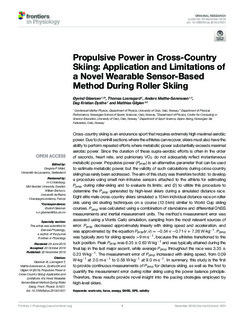| dc.contributor.author | Gløersen, Øyvind Nøstdahl | |
| dc.contributor.author | Losnegard, Thomas | |
| dc.contributor.author | Malthe-Sørenssen, Anders | |
| dc.contributor.author | Dysthe, Dag Kristian | |
| dc.contributor.author | Gilgien, Matthias | |
| dc.date.accessioned | 2019-01-03T12:53:41Z | |
| dc.date.available | 2019-01-03T12:53:41Z | |
| dc.date.created | 2018-11-21T09:11:07Z | |
| dc.date.issued | 2018 | |
| dc.identifier.citation | Frontiers in Physiology. 2018, 9, 1631. | nb_NO |
| dc.identifier.issn | 1664-042X | |
| dc.identifier.uri | http://hdl.handle.net/11250/2578989 | |
| dc.description.abstract | Cross-country skiing is an endurance sport that requires extremely high maximal aerobic power. Due to downhill sections where the athletes can recover, skiersmust also have the ability to perform repeated efforts where metabolic power substantially exceeds maximal aerobic power. Since the duration of these supra-aerobic efforts is often in the order of seconds, heart rate, and pulmonary VO2 do not adequately reflect instantaneous metabolic power. Propulsive power (Pprop) is an alternative parameter that can be used to estimate metabolic power, but the validity of such calculations during cross-country skiing has rarely been addressed. The aim of this study was therefore twofold: to develop a procedure using small non-intrusive sensors attached to the athlete for estimating Pprop during roller-skiing and to evaluate its limits; and (2) to utilize this procedure to determine the Pprop generated by high-level skiers during a simulated distance race. Eight elite male cross-country skiers simulated a 15 km individual distance race on roller skis using ski skating techniques on a course (13.5 km) similar to World Cup skiing courses. Pprop was calculated using a combination of standalone and differential GNSS measurements and inertial measurement units. The method’s measurement error was assessed using a Monte Carlo simulation, sampling from the most relevant sources of error. Pprop decreased approximately linearly with skiing speed and acceleration, and was approximated by the equation Pprop(v, ˙v) = −0.54·v −0.71·˙v + 7.26 W·kg−1. Pprop was typically zero for skiing speeds >9 m·s−1, because the athletes transitioned to the tuck position. Peak Pprop was 8.35 ± 0.63 W·kg−1 and was typically attained during the final lap in the last major ascent, while average Pprop throughout the race was 3.35 ± 0.23 W·kg−1. The measurement error of Pprop increased with skiing speed, from 0.09 W·kg−1 at 2.0 m·s−1 to 0.58 W·kg−1 at 9.0 m·s−1. In summary, this study is the first to provide continuous measurements of Pprop for distance skiing, as well as the first to quantify the measurement error during roller skiing using the power balance principle. Therefore, these results provide novel insight into the pacing strategies employed by high-level skiers. | nb_NO |
| dc.description.abstract | Propulsive Power in Cross-Country Skiing: Application and Limitations of a Novel Wearable Sensor-Based Method During Roller Skiing | nb_NO |
| dc.language.iso | eng | nb_NO |
| dc.subject | GNSS | |
| dc.subject | GPS | |
| dc.subject | energy | |
| dc.subject | force | |
| dc.subject | validity | |
| dc.subject | work rate | |
| dc.title | Propulsive Power in Cross-Country Skiing: Application and Limitations of a Novel Wearable Sensor-Based Method During Roller Skiing | nb_NO |
| dc.type | Journal article | nb_NO |
| dc.type | Peer reviewed | nb_NO |
| dc.description.version | publishedVersion | nb_NO |
| dc.rights.holder | © 2018 Gløersen, Losnegard, Malthe-Sørenssen, Dysthe and Gilgien. This is an open-access article distributed under the terms of the Creative Commons Attribution License (CC BY). The use, distribution or reproduction in other forums is permitted, provided the original author(s) and the copyright owner(s) are credited and that the original publication in this journal is cited, in accordance with accepted academic practice. No use, distribution or reproduction is permitted which does not comply with these terms. | nb_NO |
| dc.source.journal | Frontiers in Physiology | nb_NO |
| dc.identifier.doi | 10.3389/fphys.2018.01631 | |
| dc.identifier.cristin | 1633010 | |
| dc.description.localcode | Seksjon for fysisk prestasjonsevne / Department of Physical Performance | nb_NO |
| cristin.unitcode | 150,31,0,0 | |
| cristin.unitname | Seksjon for fysisk prestasjonsevne | |
| cristin.ispublished | true | |
| cristin.fulltext | original | |
| cristin.qualitycode | 1 | |
